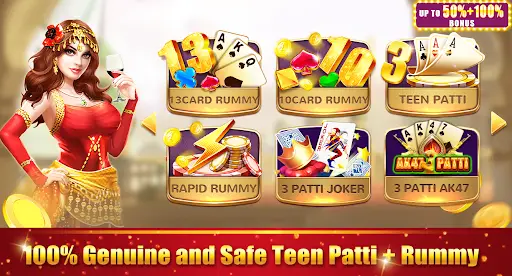Teen Patti: A Classic Card Game with Cultural Significance
Introduction:
- TEEN PATTI HEART, also known as Indian Poker or Three Card Brag, is a popular card game in South Asia.
- Its origins can be traced back to traditional Indian card games and has evolved over centuries.
- Teen Patti has gained widespread popularity not only in South Asia but also globally due to its simple rules and engaging gameplay.
Historical Background:
- TEEN PATTI HEART has roots in ancient Indian card games such as Ganjifa and Krida-patram, which were played as early as the 16th century.
- The game has been passed down through generations, with variations emerging in different regions and communities.
- It became particularly popular during festivals and social gatherings, where families and friends would gather to play and bond.
Gameplay:
- TEEN PATTI HEART is typically played with a standard 52-card deck without jokers.
- The game is best suited for 3 to 6 players, although variations exist for more players.
- Each player is dealt three cards face-down by the dealer.
- Players take turns betting chips based on the strength of their hand and their confidence in winning.
- The objective is to have the best three-card hand or to bluff opponents into folding.
Key Rules:
- Blind and Seen Bets: Players can choose to place a blind bet without looking at their cards or a seen bet after viewing their cards.
- Chaal (Call): Players must match the current bet to stay in the game.
- Pack (Fold): Players can fold their hand and forfeit any bets made.
- Show (Compare Hands): If more than one player remains after the final round of betting, hands are revealed, and the player with the best hand wins the pot.
Variations:
- Muflis: In this variation, the ranking of hands is reversed, making the lowest hand the best.
- AK47: In this variant, the cards A, K, 4, and 7 of any suit are considered the highest-ranking cards.
- Best of Four: Players are dealt four cards instead of three, but must make the best three-card hand.
- Wild Draw: Players agree on a wild card (such as the Joker) that can represent any other card.
Cultural Significance:
- Teen Patti is more than just a card game; it holds cultural significance in South Asian communities.
- It serves as a social activity that brings people together, fostering camaraderie and friendship.
- The game is often accompanied by lively conversation, friendly banter, and shared snacks and drinks.
- Teen Patti is also featured prominently in movies, literature, and cultural events, further cementing its place in society.
Social Dynamics:
- Teen patti heart reflects and reinforces social hierarchies and dynamics within groups.
- Players may develop reputations based on their playing style, luck, and skill, leading to friendly rivalries and alliances.
- The game provides a platform for individuals to showcase their bluffing abilities, strategic thinking, and emotional control.
Psychological Aspects:
- Teen patti heart involves a blend of skill, strategy, and chance, making it psychologically intriguing.
- Players must assess probabilities, read opponents’ body language and betting patterns, and manage their emotions.
- The thrill of risk-taking and the uncertainty of outcomes contribute to the game’s appeal and addictive nature.
Online and Mobile Platforms:
- In recent years, Teen Patti has transitioned to online and mobile platforms, reaching a wider audience.
- Players can now enjoy the game anytime, anywhere, without the need for physical cards or a group of players.
- Online Teen Patti offers various features such as multiplayer modes, tournaments, and virtual rewards.
Criticism and Controversies:
- Despite its popularity, Teen patti heart has faced criticism from some quarters, particularly due to its association with gambling.
- Concerns have been raised about its potential for addiction, especially among vulnerable populations.
- Some argue that the game perpetuates harmful stereotypes and glamorizes risky behavior.
TEEN PATTI HEART (:-
Regulatory Issues:
- The legal status of Teen patti heart varies depending on jurisdiction, with some countries banning or restricting gambling activities.
- In India, Teen patti heart is subject to gambling laws that vary by state, with some states permitting it in regulated settings.
- The rise of online Teen Patti has prompted debates about regulation and responsible gaming practices.
Rules of the Game: Teen patti heart is typically played with 3 to 6 players, with each player dealt three cards face-down. The game revolves around betting and hand rankings, similar to poker. Here are the basic rules:
- Ante: Before the cards are dealt, all players must place a predetermined amount of money into the pot, known as the ‘ante’.
- Boot Amount: In some variations, a ‘boot’ or initial contribution is made by the player seated to the dealer’s left.
- Dealer: The dealer distributes three cards to each player, rotating clockwise with each round.
- Betting Rounds: Players take turns betting based on the strength of their hand or bluffing to deceive opponents.
- Hand Rankings: Hands are ranked similar to poker, with variations allowing for different combinations such as a trail (three of a kind), pure sequence, sequence, color, pair, and high card.
- Showdown: After betting rounds, players who haven’t folded reveal their cards, and the player with the highest-ranking hand wins the pot.
Variations: Teen patti heart boasts numerous variations, each adding unique twists and strategies to the game. Some popular variations include:

- Muflis: In this variant, the ranking of hands is reversed, with the lowest-ranking hand winning the pot.
- AK47: Players receive four specific cards – Ace, King, Four, and Seven – which hold special significance and higher value.
- Best of Four: Players are dealt four cards instead of three, and they must make the best possible hand using any three of their four cards.
- Joker: One or two jokers are added to the deck, serving as wild cards that can represent any other card to form a winning hand.
Cultural Significance: Teen Patti transcends being just a card game; it holds deep cultural significance in Indian society. It serves as a medium for social bonding, fostering friendships and community ties. The game is often accompanied by lively banter, laughter, and shared experiences, strengthening interpersonal relationships. Moreover, Teen Patti reflects Indian values of camaraderie, hospitality, and the importance of leisure in everyday life.
Influence on Popular Culture: Teen Patti has permeated various aspects of Indian popular culture, including movies, music, and literature. Several Bollywood films have depicted the game, portraying its thrill and intensity on the silver screen. Songs and poems have been dedicated to Teen Patti, celebrating its essence and allure. Additionally, literature has explored the game’s metaphorical significance, using it as a symbol of life’s uncertainties and the art of bluffing.
Digital Transformation: With the advent of technology, Teen patti heart has undergone a digital transformation, reaching a broader audience through online platforms and mobile apps. Players can now enjoy the game anytime, anywhere, without the need for physical cards or gatherings. Online Teen Patti offers various features such as multiplayer modes, tournaments, and social interactions, enhancing the gaming experience while retaining the essence of traditional gameplay.
Impact of Globalization: The globalization of Teen patti heart has led to its recognition beyond Indian borders, attracting players from diverse cultural backgrounds. International tournaments and competitions have further popularized the game on a global scale, showcasing India’s rich gaming heritage. The fusion of traditional gameplay with modern technology has created a bridge between cultures, fostering cross-cultural exchanges and mutual appreciation.



